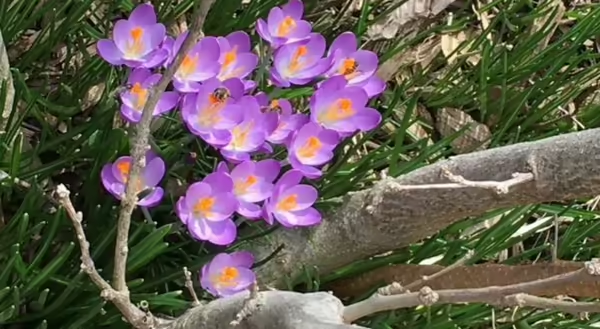
Daffodils, Tulips, Crocus and Hyacinth bulbs seem to materialize from snow on the saturated ground, provoking gardeners to celebrate the coming spring. However, gardeners are not planting these hardy bulbs in the spring soil, but the previous fall to over-winter in their garden beds.
Bulbs require a chilling period in order to grow and flower. The optimal time for Illinois gardeners to plant bulbs is the month of October. Too early and you risk an issue with Fusarium bulb rot, which causes yellow foliage, poor root systems, bulb decay, and early death. The ideal temperature for Fusarium to flourish is around 80 degrees. But that doesn’t mean later is necessarily better. Plant bulbs after the month of October and you risk the roots not growing sufficiently to make it through the winter.
Spring flowering bulbs store their entire life cycle within a compressed underground stem that contains fleshy scales. Although treated like a bulb, a crocus is technically a corm, which features a swollen stem without the fleshy scales.
While bulbs require a chilling period, they don’t exactly go dormant after flowering in the spring—I can always find grape hyacinth foliage in our pollinator garden starting in late September. Bulbs planted in previous years will resume growing in the fall in order to obtain nutrients and moisture.
Most spring-flowering bulbs are reliable year-after-year bloomers once they are planted. Some, like daffodils, crocus, blue scillia, glory of the snow, and snow drops, will begin to naturalize (spread through your yard).
Bulbs like Hyacinth and tulips may not be reliable bloomers, and I usually recommend planting new bulbs every year. If you notice less blooming than usual in established beds, then it may be time to transplant bulbs to a new location, giving them more room to grow. The best time to do this is after the foliage has turned yellow in the spring.
"Tulip bulbs do not like our heavy, wet soils, and they rot in the ground, says Martha Smith, extension horticulture educator. "The rot is particularly susceptible where the flowering stalk was and now leaves a depression in the bulb, allowing water to collect."
She says pull up each year, plant sideways, and the bulb will naturally straighten again by the time it has flowered.
You may find a large bulb connected to much smaller bulbs. These new bulbs, called offsets, will grow, but may take a year or two to flower. The larger bulb can also be replanted, but check first for firmness and discoloration (brown spots) from disease. Gardeners can always choose to store rather than replant right away, then plant in October. Store these bulbs in a mesh bag for good air circulation. A cool basement is ideal.
Most garden centers are getting their bulb orders in now, so move quickly to ensure you get your favorites. However, store them in a well-ventilated, cool place until you are ready to plant in October.